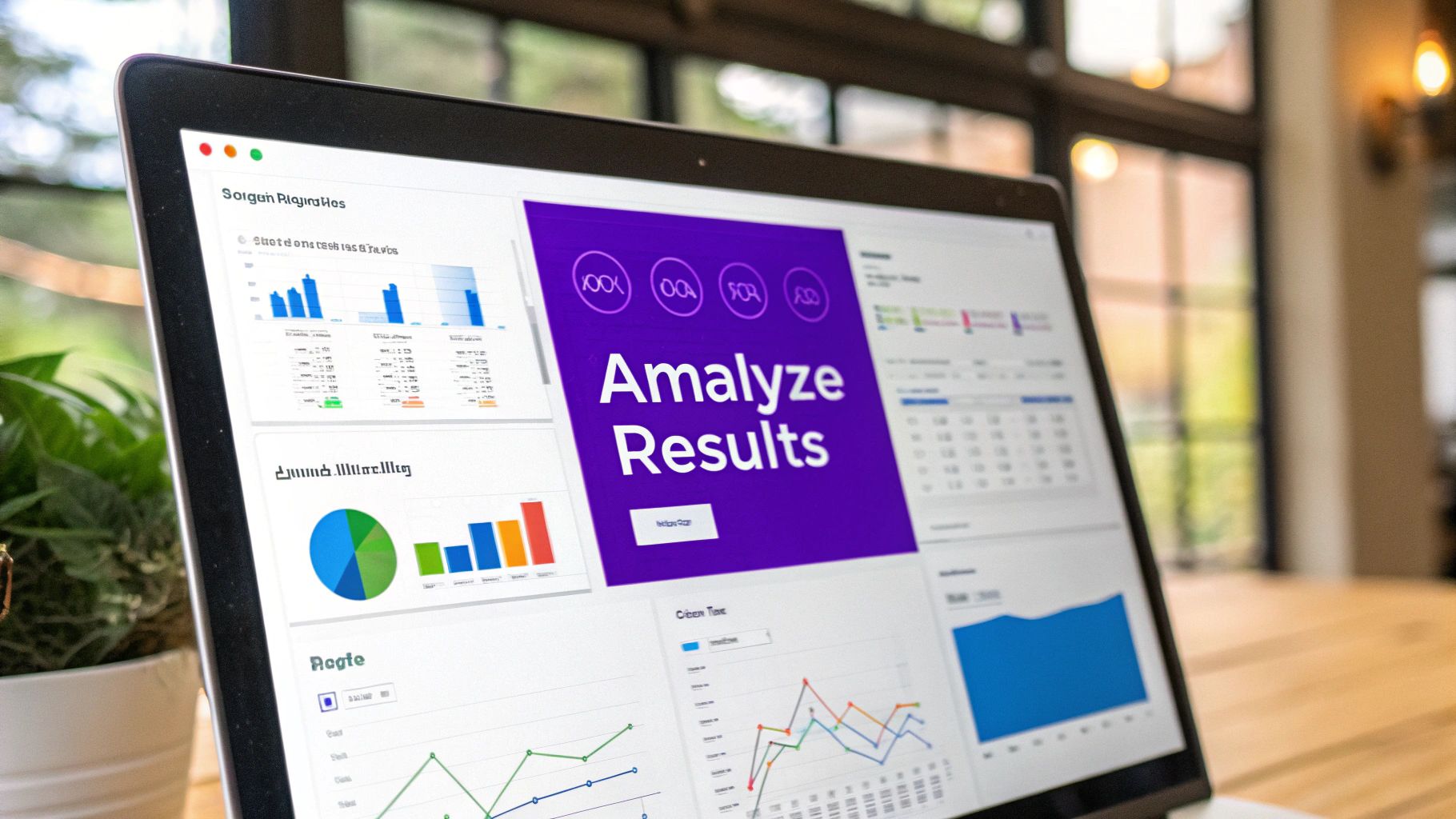How to Create a Marketing Plan: A Step-by-Step Guide for Success

Setting Clear Marketing Goals That Drive Growth

Every successful marketing plan needs well-defined goals to guide the way. Think of it like planning a road trip - you need to know your destination before you start driving. Without clear goals, you're just wandering around hoping for results. Let's explore how to set meaningful marketing goals that will help your business grow.
Defining SMART Goals
The foundation of any good marketing plan starts with SMART goals. This proven framework stands for goals that are Specific, Measurable, Achievable, Relevant, and Time-bound. A specific goal clearly states what you want to accomplish. Measurable goals use real numbers to track progress. Achievable goals challenge you while staying realistic. Relevant goals connect directly to your business needs. Time-bound goals have clear deadlines to keep you on track.
Translating Business Objectives into Marketing Targets
Your marketing goals should directly support what your business wants to achieve overall. For example, if you want to grow your customer base, your marketing goal might focus on reaching new audiences in specific areas. This ensures all your marketing efforts help the bottom line. The key is turning big business goals into specific marketing actions you can measure.
Adapting to Market Changes
The business world keeps changing, and your marketing goals need to be flexible enough to change with it. Regular market research helps you spot when it's time to adjust your approach. For instance, if your customers' needs shift, you may need to update your messaging or focus on different audiences. According to recent data, 77% of marketers have updated their marketing plans after sharing them with leadership teams. Learn more about presenting marketing plans effectively.
Tracking Progress and Avoiding Vanity Metrics
While tracking numbers is important, watch out for vanity metrics that look good but don't mean much. Having lots of social media followers sounds great, but it doesn't help if they never buy anything. Focus instead on metrics that show real business impact, like sales conversion rates, customer value over time, and return on your marketing spending. These numbers tell you if your marketing is truly working and help guide your next moves.
Mastering Market Research That Reveals Hidden Opportunities
Good market research helps you truly understand your customers and spot exciting chances for growth. By going beyond basic assumptions, you'll learn what drives people's choices and how your business can better serve them.
Combining Qualitative and Quantitative Research
The best insights come from mixing two research approaches. Qualitative research helps you understand the "why" - what motivates people and shapes their opinions. You can gather these insights through customer interviews, focus groups, and open surveys. Quantitative research gives you the hard numbers through website data, sales figures, and multiple-choice surveys to back up what you learn.
Building Buyer Personas That Show Your Real Audience
Good research helps create buyer personas - profiles that represent your ideal customers. These go deeper than basic age and location to uncover what people truly care about. For example, your target customer might prioritize eco-friendly products and convenience above all else. Understanding these motivations helps you craft messages that really connect with people.
Finding Gaps Your Competitors Miss
Knowing your competition is just as important as knowing your customers. Study what other companies do well and where they fall short. Look for unmet customer needs or groups that aren't being served well. Maybe there's a specific feature everyone wants but no one offers yet. These gaps are your chance to stand out and win customers.
Using Data to Make Smart Choices
Research shows that 81% of people need to trust a brand before buying from them. Learn more about key marketing stats. Good research helps you develop your unique selling proposition (USP) - what makes your business special. When you understand both data and customer needs, you can make better choices about your products, prices, and marketing. This helps you build trust with customers while highlighting what makes you different from competitors.
Creating Content That Captivates Your Target Audience

Great content does more than just fill your blog and social media feeds - it builds real connections with your audience. A solid content strategy helps you create material that your audience truly wants and needs. Let's explore how successful brands are using content to engage their audiences and hit their marketing targets.
Understanding Your Audience
Getting to know your target audience is step one in creating content that connects. Build detailed buyer personas that dig deep into who they really are. What keeps them up at night? What are their goals? What information are they searching for? For example, if you work with Etsy sellers, content about growing their online shops will resonate more than basic website tips.
Developing a Content Calendar
A content calendar keeps your content creation organized and flowing smoothly. Think of it as your content roadmap - it helps you plan topics, choose formats, and pick the right channels to share your message. Good planning ensures your content aligns with your campaigns and keeps your audience engaged.
Choosing the Right Content Formats
Your audience has preferences for how they like to consume content. Some love reading in-depth blog posts, while others prefer quick video tutorials. Try mixing it up with different formats like infographics for data visualization or social media for quick updates. Get creative with your existing content too - turn that popular blog post into social media snippets or transform your latest webinar into a downloadable guide.
Measuring Content Performance
Creating great content is just the beginning - you need to track how it performs. Watch your key metrics like website visits, social engagement, leads generated, and sales. Use this data to fine-tune your approach and make sure your content drives real results. Many businesses skip this crucial step - in fact, 63% of companies don't have a written content strategy at all, which can lead to scattered efforts. Find more detailed statistics here.
Building a Strategic Budget That Maximizes ROI
Creating a marketing budget that delivers results requires moving beyond just setting spending limits. The goal is to invest resources effectively to maximize your return while demonstrating clear value to stakeholders. Let's explore how to build a budget with the most impact.
Forecasting Returns and Prioritizing Investments
Smart forecasting helps guide your budget allocation. Look at past performance data - if your email campaigns deliver 2x better ROI than social media ads, invest more heavily in email. Focus on building evergreen content assets like helpful blog posts or video tutorials that keep attracting and converting audiences long after creation. These provide better long-term value compared to one-off ad campaigns.
Building Flexibility Into Your Budget
While having structure is important, keeping some budget flexible is crucial. Think of it like planning a road trip - you map the route but need backup options if detours arise. Market shifts and new opportunities may require quick spending adjustments. Set aside a 10-15% contingency fund to capitalize on emerging trends or address unexpected needs.
Tracking and Measuring for Success
Monitor campaign performance in real-time using analytics tools to understand what's working. Set clear Key Performance Indicators (KPIs) tied to business goals - like website traffic growth, qualified leads generated, or sales conversions. According to recent data, 48% of companies invest 4-10% of revenue in marketing, highlighting how critical strategic budgeting is for growth. Learn more about marketing investment trends.
Presenting Your Budget and Winning Approval
When presenting budgets to leadership, focus on projected returns and business impact. Use clear data visualizations to show how investments drive results - like how SEO spending grows organic traffic and sales over time. Back up recommendations with competitive benchmarks and industry standards. A strong, numbers-backed proposal demonstrates the strategic value of your marketing plan.
Executing Campaigns That Deliver Measurable Results

Moving from planning to action requires running focused campaigns that deliver clear results. Think of it like directing an orchestra - every section needs to work together perfectly to create beautiful music. The key is coordinating your marketing channels while keeping your message consistent across them all.
Coordinating Multi-Channel Campaigns
Getting all your marketing channels to work together takes careful planning. When launching a promotion, make sure your social posts, emails, and website all tell the same story. This helps build brand recognition and gives customers a smooth experience, no matter how they find you.
Allocating Resources Efficiently
Smart resource planning is like setting a household budget - you need to match your team's skills with your top priorities. Using a Gantt chart helps visualize who's doing what and when, keeping everyone on track. Here's a simple way to break it down:
| Resource | Task | Deadline | Responsible |
|---|---|---|---|
| Design | Social Media Graphics | Week 1 | Team A |
| Content | Email Copywriting | Week 2 | Team B |
| Analytics | Performance Monitoring | Week 3 | Team C |
Monitoring and Adjusting in Real-Time
Keep a close eye on how your campaign performs using tools like Google Analytics or Hootsuite. Watch your metrics and make quick changes based on what's working. Just like a good chef tastes and adjusts seasoning, you should fine-tune your approach based on real data.
Managing Stakeholder Expectations
Clear updates help keep everyone informed and happy with progress. Regular check-ins let you share wins and stay transparent with stakeholders. Remember to celebrate small victories - they keep the team motivated and show how everyone's work adds up to bigger successes.
Running strong campaigns needs both careful planning and quick thinking. When you nail the mix of coordination, smart resource use, and performance tracking, your campaigns can hit their goals and help grow your business.
Measuring Success and Optimizing Performance

Getting your marketing plan up and running is just the first step. The real magic happens when you start measuring how well it's working and making smart improvements. Think of it like tending a garden - you need to keep an eye on what's growing well and adjust your approach based on what you learn.
Establishing Key Performance Indicators (KPIs)
Before you can measure success, you need to know what success means for your business. Key Performance Indicators (KPIs) are the specific numbers that tell you if you're hitting your goals. Want to build brand recognition? Track things like website visitors and social media engagement. Focused on sales? Keep tabs on conversion rates and average order values. The key is picking KPIs that directly connect to what matters most for your business.
Setting Up a Measurement Framework
Think of your measurement framework as your business dashboard. Pick the right tools to track your numbers - Google Analytics is great for website data, while social media platforms have built-in stats. Create simple dashboards to spot trends at a glance. Set up weekly or monthly check-ins to stay on top of how things are going.
Analyzing Performance and Identifying Trends
Raw numbers only tell part of the story. The real insights come from understanding why those numbers change. Did your website traffic spike after that blog post went viral? Did sales drop when you changed your checkout process? Look for these patterns - they show you what's actually working (or not working) with your marketing.
Optimizing Your Marketing Plan Based on Insights
This is where data becomes action. Use what you learn to make your marketing better:
- Double down on content types your audience loves
- Shift money away from ads that aren't performing
- Fix website issues that are causing people to leave
- Create more of what's already working well
Keep testing, measuring, and improving. Small tweaks based on real data can lead to big results over time.
Ready to take your e-commerce business to the next level? Wand Websites builds high-performing Shopify stores that help you sell more and grow your brand. Visit us today to learn how we can help.


